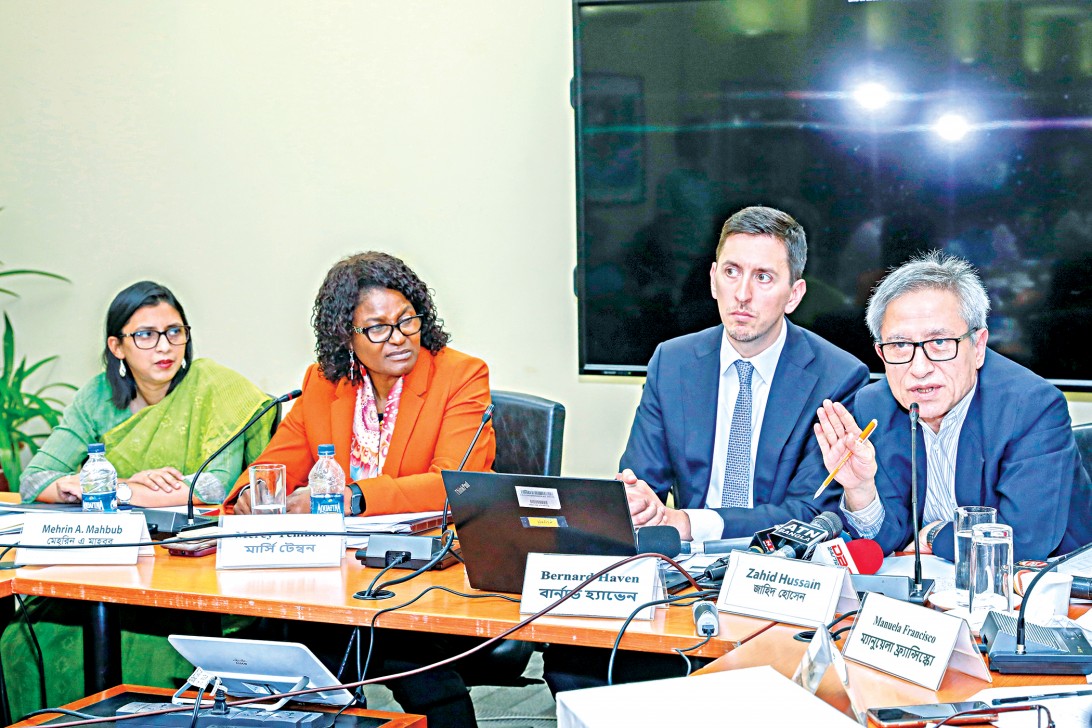Banking ills can derail growth

Banking sector vulnerabilities and uncertain global outlook stand to take the momentum off the economy that looks set to grow at a robust pace in the medium term, the World Bank said in its latest update on Bangladesh.
“In Bangladesh, downside risks are primarily domestic,” said the Washington-based multilateral lender in the report, which was unveiled yesterday at its office in Dhaka.
Private sector credit growth was weak, constrained by banking sector liquidity.
And one of the reasons liquidity remains constrained is the high default loans, which continued to rise.
As of June, the default loan ratio stood at 11.7 percent of total outstanding loans, up from 10.4 percent a year earlier.
And the default loans are not evenly distributed, with the state banks accounting for almost half of the total -- a result of directed lending, poor risk management, and weak corporate governance and prudential oversight, it said.
“Weak governance in the banking sector could impair its capacity to extend credit and support growth if the economy slows down,” said Bernard Haven, senior economist of the WB and co-author of the report.
For the banking sector, the overall and Tier 1 capital to risk-weighted assets ratio (CRAR) marginally exceeds internationally accepted minimum requirements. The latest stress test by the Bangladesh Bank in December 2018 indicates that credit concentration risk is threat to capital adequacy.
“For example, the default of the top three large borrowers results in 22 out of 48 complying banks falling below the minimum regulatory CRAR.”
Furthermore, the central bank has made several concessions in the loan classification rules and write-off policies that are a departure from the global norms enacted in 2012 following the Basel III guidelines.
This has affected the confidence of foreign suppliers on the ability of domestic banks to honour letters of credit payment obligations.
As a result, LCs issued by domestic banks commonly require confirmation by a correspondent bank to be acceptable by overseas suppliers, which has increased the financing cost of import transactions.
Meanwhile, other than the rising default loans, the declining deposit growth, US dollar sales by the BB to moderate the exchange rate and pressure on banks to limit lending rates to 9 percent also constrained the banks’ supply of loanable funds.
“Increased bank borrowing by the government in such a situation will increase the risk of crowding out the private sector with adverse effects on private investments.”
The external risks are also rising, although Bangladesh may benefit from trade diversion in the short term.
“Tariff escalation by the US against China may provide a further boost to exports in the short run if Bangladesh can capture some of the trade diversion.”
But slower growth forecast in Bangladesh’s major export markets can also slowdown the country’s momentum.
Euro area growth is projected to fall from 1.8 percent in 2018 to 1.4 percent in 2020, while growth in the US is forecast to decline from 2.9 percent in 2018 to 1.7 percent in 2020.
There could also be a loss of competitiveness through exchange rate appreciation because of the BB’s interventions in the foreign exchange market to stabilise the taka-US dollar rate, the WB said.
The report found that public investment management (PIM) remains a challenge as the annual development programme continues to be overloaded with too many projects while time and cost overruns remain ubiquitous.
Subsequently, the WB called for closing the infrastructure gap and timely implementation of ADP.
“Bangladesh’s economy is projected to maintain strong growth backed by sound macroeconomic fundamentals and progress in structural reforms,” said Mercy Miyang Tembon, country director of the WB for Bangladesh and Bhutan.
“Bangladesh will need a high-productivity economy to achieve its growth vision.”
The WB has forecast the Gross Domestic Product (GDP) growth rate of Bangladesh at 7.2 percent for 2019-20, while the government’s projection for the same fiscal year in the national budget was 8.2 percent.
The GDP growth rate for 2018-2019, officially estimated at 8.1 percent, was higher than the previous fiscal year’s rate of 7.9 percent, the report says, though it predicts a relatively lower growth for the upcoming fiscal year.
